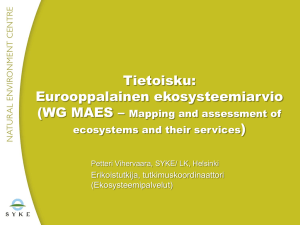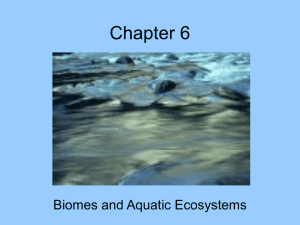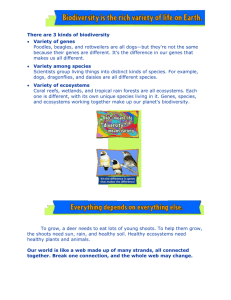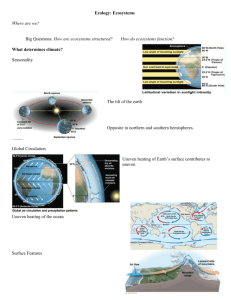SNC1P: Science, Grade 9, Applied
advertisement
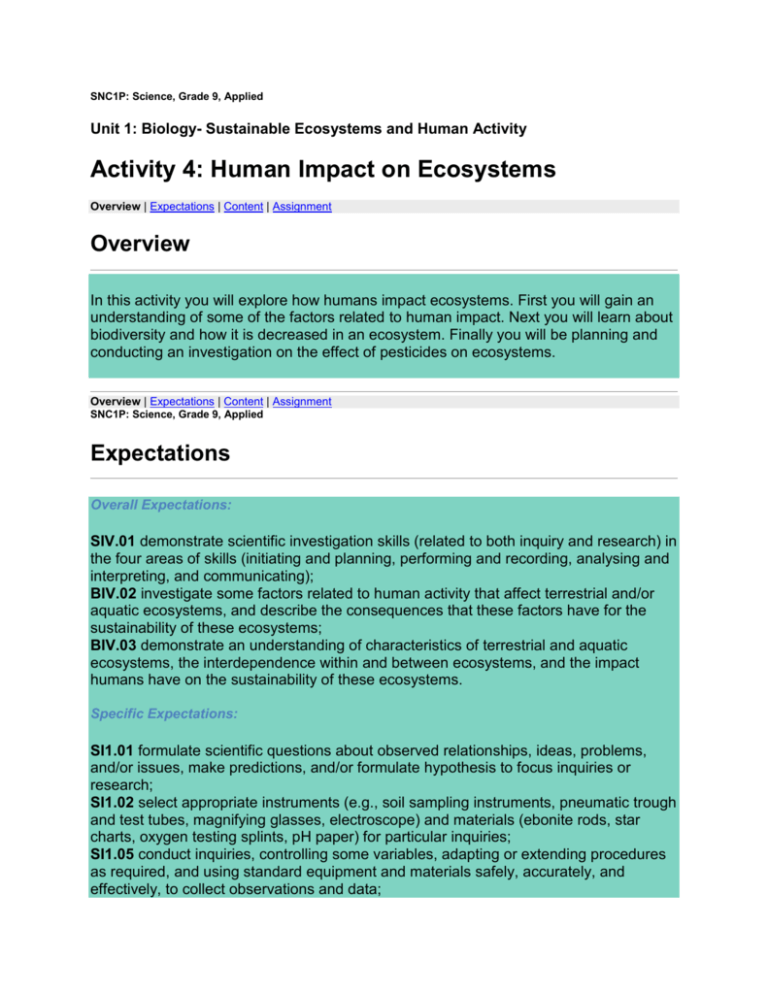
SNC1P: Science, Grade 9, Applied Unit 1: Biology- Sustainable Ecosystems and Human Activity Activity 4: Human Impact on Ecosystems Overview | Expectations | Content | Assignment Overview In this activity you will explore how humans impact ecosystems. First you will gain an understanding of some of the factors related to human impact. Next you will learn about biodiversity and how it is decreased in an ecosystem. Finally you will be planning and conducting an investigation on the effect of pesticides on ecosystems. Overview | Expectations | Content | Assignment SNC1P: Science, Grade 9, Applied Expectations Overall Expectations: SIV.01 demonstrate scientific investigation skills (related to both inquiry and research) in the four areas of skills (initiating and planning, performing and recording, analysing and interpreting, and communicating); BIV.02 investigate some factors related to human activity that affect terrestrial and/or aquatic ecosystems, and describe the consequences that these factors have for the sustainability of these ecosystems; BIV.03 demonstrate an understanding of characteristics of terrestrial and aquatic ecosystems, the interdependence within and between ecosystems, and the impact humans have on the sustainability of these ecosystems. Specific Expectations: SI1.01 formulate scientific questions about observed relationships, ideas, problems, and/or issues, make predictions, and/or formulate hypothesis to focus inquiries or research; SI1.02 select appropriate instruments (e.g., soil sampling instruments, pneumatic trough and test tubes, magnifying glasses, electroscope) and materials (ebonite rods, star charts, oxygen testing splints, pH paper) for particular inquiries; SI1.05 conduct inquiries, controlling some variables, adapting or extending procedures as required, and using standard equipment and materials safely, accurately, and effectively, to collect observations and data; SI1.06 gather data from laboratory and other sources, and organize and record the data using appropriate formats, including tables, flowcharts, graphs, and/or diagrams; SI1.08 analyse and interpret qualitative and/or quantitative data to determine whether the evidence supports or refutes the initial prediction or hypothesis, identifying possible sources of error, bias, or uncertainty; SI1.10 draw conclusions based on inquiry results and research findings, and justify their conclusions; SI1.11 communicates ideas, plans, procedures, results, and conclusions orally, in writing, and/or in electronic presentations, using appropriate language and a variety of formats (e.g., data tables, laboratory reports, presentations, debates, simulations, models); BI2.03 compile and graph data (both qualitative and quantitative) on biodiversity within an undisturbed and disturbed ecosystems (terrestrial or aquatic); BI2.04 plan and conduct an inquiry into how a factor related to human activity affects terrestrial or aquatic ecosystems (e.g. how changes to soil composition from the use of different compostable materials or organic or inorganic fertilizers affect the types of plants that can be grown; how lower water levels resulting from water diversion affect waterfowl nesting areas and fish reproduction), and describe the consequences that this factor has for the sustainability of the ecosystem; BI2.05 analyse the effect of factors related to human activity on terrestrial and/or aquatic ecosystems by interpreting data and generating graphs (e.g., data on the concentration in water of chemicals from fertilizer runoff and their effect on the growth of algae); BI3.05 identify some factors related to human activity that have an impact on ecosystems (e.g., use of fertilizers and pesticides; organic and conventional farming; urban sprawl), and explain how these factors affect the equilibrium and survival of populations in terrestrial and aquatic ecosystems (e.g., fertilizers affect the fertility of soil, affecting what types of plants can grow in it; pesticides leach into water systems, affecting water quality and aquatic life; urban sprawl wipes out fields and woods, destroying wildlife habitats). Overview | Expectations| Content | Assignment Content There are many ways that humans affect the ecosystem in which they live. Some of these effects are outlined below. Pesticides Pesticides are intended to kill pests, but they kill organisms other than the targeted pests. For example, pesticides can kill bees that are needed to pollinate crops. Some pesticides have also been shown to be harmful to humans. Spraying pesticides over a field. Fertilizers Fertilizers entering aquatic ecosystems can have several effects. Fertilizers contain nitrates and phosphates, which increase algae growth in aquatic ecosystems. The algae at the top of the water block the sunlight causing plants deeper in the water to die. Decomposers (bacteria) break down the dead plant matter and dying algae, using up the oxygen in the water. As a result, fish and other aquatic animals that require high oxygen levels will die. Algal bloom produced in a river. In a terrestrial ecosystem, the extra fertilizer in the soil can damage tree roots, cause needles on trees to yellow, and stunt tree growth. Did you know? That too much fertilizer entering an aquatic environment can cause population explosion of algae? This is called an algal bloom. Pollution from the Burning of Fossil Fuels The gases emitted from industrial smokestacks, vehicle exhaust, and power plants can produce acid precipitation (acid rain) when they combine with water in the atmosphere. The acid precipitation entering aquatic ecosystems has killed fish, birds, amphibians, and other organisms. Scientists believe sugar maple trees are also damaged by acid precipitation. Pollution produced from an industry burning fossil fuels. Did you know? That the only solution to acid rain at the present time is to dump large quantities of powdered limestone into the water to neutralize the acid? Next Content Effects on Species The human impact on ecosystems is causing a decreased number of species on Earth. The variety of species on Earth or in an ecosystem is called biodiversity. Biodiversity is reduced by extreme conditions such as areas that: are very hot or very cold; have a high acidity level; are very wet or dry; have high nutrient levels. Biodiversity is seen in the Polynesian rainforest. For example, high acidity in lakes has decreased biodiversity. Although fish will vary in their sensitivity to acid concentrations, Canadian lakes affected by acid precipitation show less biodiversity than the past. Check Your Understanding Answer the following questions in your notebook. Complete the questions in sentence form where appropriate. Check your answers for each question. 1. Define the term biodiversity. Answer 2. Pesticides can prevent _______ from pollinating crops. Answer 3. List two effects that fertilizers have on an aquatic ecosystem. Answer 4. Use the resource sites below as a guide for this question. Why is over-fishing a problem for aquatic ecosystems? Answer 5. What are some of the causes of acid precipitation? Answer Resources To learn more about this topic you may wish to visit the following sites: Human Activities and their Impacts http://canadianbiodiversity.mcgill.ca/english/conservation/activities.htm This is a disclaimer. External Resources will open in a new window. Not responsible for external content. Unless otherwise indicated, all images in this Activity are from the public domain or are © clipart.com or Microsoft clipart and are used with permission. Assignment: Choose one of the following areas where human activity impacts ecosystems: Fishing, Forestry Urbanization and Development Agriculture Industry Write three paragraphs focusing on the following with regards to your human activity Species Protecting Ecosystems Deciding what gets protected




